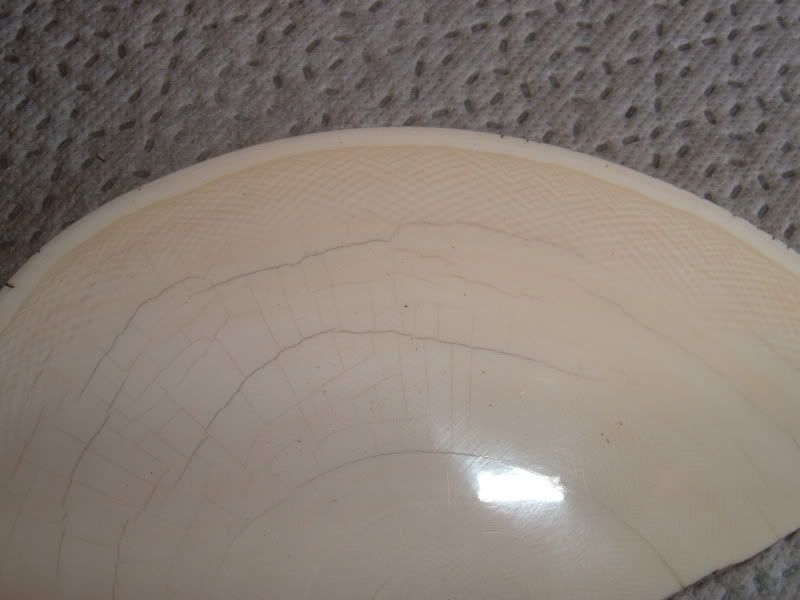Results 1 to 10 of 40
Thread: Identifying Ivory
Hybrid View
-
06-19-2012, 02:48 PM #1Senior Member


- Join Date
- Jan 2011
- Location
- Roseville,Kali
- Posts
- 10,432
Thanked: 2027
You will never see the Schreger Lines (cross hatching) on scales,only from an end cut view,scales are cut along the lenth of the tusk section and the cross hatching becomes wavy lines.
As above, Ivory will burn,it will not melt and the smell you get is like being at the dentists office when having your teeth ground on.

-
The Following User Says Thank You to pixelfixed For This Useful Post:
DFriedl (06-19-2012)
-
06-19-2012, 03:50 PM #2"My words are of iron..."


- Join Date
- Oct 2006
- Posts
- 1,898
Thanked: 995
+1 on pixelfixed's picture. One more from a cut of mammoth ivory would complete the set. The angle of the Schreger lines is/are different for mammoth.
Here's a good resource: All About Mammoth Ivory
-
The Following User Says Thank You to Mike Blue For This Useful Post:
DFriedl (06-19-2012)
-
06-19-2012, 04:15 PM #3Senior Member


- Join Date
- Jan 2011
- Location
- Roseville,Kali
- Posts
- 10,432
Thanked: 2027
-
06-19-2012, 04:25 PM #4Senior Member



- Join Date
- Apr 2008
- Location
- Essex, UK
- Posts
- 3,816
Thanked: 3164
Pixelfixed is correct - the smell generated when working elephant ivory is just like at the dentists - when he drills your teeth. That is because an elephant's tusk is really a huge, specialised tooth so it is made from the same materials (dentine and enamel) and thus smells the same when drilled/sanded. The main part of the tusk is composed of dentine. The enamel mainly protects the tip of the tusk and is gradually worn away.
The waves/schreger lines are't always as apparent as in Pixelfixed's photo though - sometimes they can only be seen at the edges of the scales, sometimes it is very hard to make them out at all. They are most prominent the nearer you get to the central core (pulp cavity).

I'm not too sure about it being translucent around the edges like horn being a good identifier - it is pretty dense stuff, denser than horn (which is derived from keratin, like hair - it smells like hair when burned) and has opaque mineral deposits and cementum in it. I suppose you could make it very thin at the edges, but I have never seen ivory scales like that - it makes them prone to chip (it is a brittle substance) and most edges are finished at an angle somewhere between 35 and 50 degrees to the horizontal.
Also, it's not a good idea to soak ivory. The stuff is dimensionally unstable enough as it is, and swells as it absorbs water. It also loses water over time and contracts. You can see the effects of this at the pinning points on most old seven-day sets of razors in ivory scales - a good number will have split at the pin due this movement, coupled with flaring the pins too tightly in the pivot holes.
You can rehydrate ivory, though. A very light mineral or vegetable oil, or even glycerin can be applied to the scales and allowed to seep in. You can see just how much it sinks in with examples of ivory scaled razors that have been over-zealously oiled at the pivot point - it leaves a horrible looking stain, often tinged with rust or brass/copper from the filings generated by opening and closing the blade.
Regards,
NeilLast edited by Neil Miller; 06-19-2012 at 04:29 PM.
-
The Following 10 Users Say Thank You to Neil Miller For This Useful Post:
BanjoTom (06-19-2012), bonitomio (06-20-2012), DFriedl (06-19-2012), nipper (06-20-2012), pixelfixed (06-19-2012), rolodave (06-19-2012), ScottGoodman (06-22-2012), Steel (06-09-2016), str8fencer (06-19-2012), Suavio (03-06-2014)
-
06-19-2012, 04:52 PM #5

Yet another master class at SRP.
Thank you to everyone above for sharing for our benefit.
-
06-20-2012, 06:31 AM #6
-
06-20-2012, 08:14 AM #7Junior Member

- Join Date
- Mar 2012
- Location
- Rome, Italy
- Posts
- 19
Thanked: 3
you impress me guys, really.
-
06-20-2012, 03:21 PM #8

Also Narwhale is really special stuff because of the twist the tusk has but the stuff is probably impossible to get.
-
06-19-2012, 04:55 PM #9Seņor Member (the name is Dave)


- Join Date
- Feb 2012
- Location
- Sarver, Pennsylvania, United States
- Posts
- 683
Thanked: 88
Thanks. I'm fairly sure these scales actually are ivory, but will need to check when I get home. You guys are great; I'm not bad a finding data online, but there is an awful lot of useless stuff out there about ivory, and this is a very usefull distilled set of information.
-
06-19-2012, 07:42 PM #10Thread derailment specialist.



- Join Date
- Dec 2011
- Location
- Republica de Tejas
- Posts
- 2,792
Thanked: 884
I have two razors with ivory scales. On both sets the scales are very thin. I would imagine that since you've cleaned and sanded yours that they are pretty much white now. Ivory yellows with age and handling. The grain in ivory is rarely ( from what I've seen ) like the lines you see in in faux or "French ivory which is celluloid. The celluloid has very regular grain in it whereas ivory is pretty random.
Here is a fairly close view of one.

and another view of another

a typical break

with a view of bone thrown in



 16Likes
16Likes LinkBack URL
LinkBack URL About LinkBacks
About LinkBacks






 Reply With Quote
Reply With Quote

